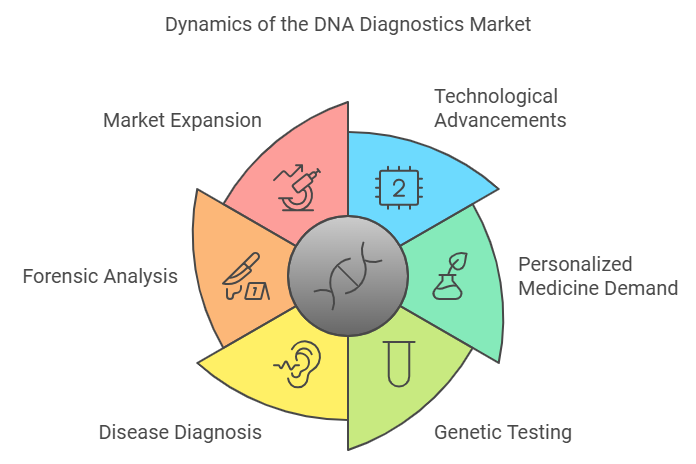Introduction
As the demand for precision medicine rises, the DNA Diagnostics Market continues to experience substantial growth. This market is fueled by advancements in technology, such as next-generation sequencing (NGS), polymerase chain reaction (PCR), and microarrays, which have transformed genetic testing, making it more accessible, efficient, and reliable.

Key Trends in the DNA Diagnostics Market
- Personalized Medicine
DNA diagnostics enable healthcare providers to personalize treatment plans based on patients’ genetic profiles. This trend has led to an increasing demand for DNA diagnostic tests in oncology, infectious diseases, and inherited disorders. - Next-Generation Sequencing (NGS) Growth
NGS technology allows for comprehensive genomic analysis, aiding in early diagnosis and treatment planning. The integration of NGS in clinical practice has driven the DNA diagnostics market, providing faster results and greater accuracy. - Increased Focus on Oncology
With cancer being a significant health concern globally, the DNA diagnostics market is seeing a surge in demand for oncology testing. DNA diagnostics enable early detection of cancer markers and guide treatment strategies, particularly in personalized oncology.
Market Drivers and Growth Opportunities
- Rising Prevalence of Genetic Disorders
The increasing incidence of genetic disorders has driven healthcare providers to adopt DNA diagnostic tools for early detection and intervention. As awareness grows, so does the need for advanced diagnostics in genetic disease management. - Government Initiatives and Funding
Government support for genetic research and diagnostics is a significant driver for market growth. Funding initiatives aimed at improving healthcare infrastructure and advancing genomics research create numerous opportunities for market players. - Technological Advancements
The continuous evolution in DNA diagnostic tools, such as real-time PCR and microarrays, has improved testing accuracy and efficiency. Technological advancements also help reduce testing costs, making these solutions more accessible across various healthcare settings.
Challenges in the DNA Diagnostics Market
While the market is growing, challenges remain. These include the high cost of DNA diagnostic tests, regulatory hurdles, and concerns about data privacy in genetic testing. Addressing these challenges will be crucial for market players to gain a competitive edge.
Conclusion
As technological innovation continues to reshape the DNA diagnostics landscape, the market is poised for significant growth. Companies that can navigate challenges while capitalizing on emerging trends and drivers are likely to benefit the most in the coming years.